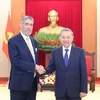Minister of Industry and Trade Vu Huy Hoang has written an article on the occasion of the 45th founding anniversary of the Association of Southeast Asian Nations (ASEAN) reviewing the group’s development and 17 years of Vietnam’s positive and active participation.
ASEAN, which was established in 1967, includes 10 members, namely Brunei, Cambodia, Indonesia, Laos, Malaysia, Myanmar, the Philippines, Singapore, Thailand and Vietnam .
During 45 years of development, ASEAN has affirmed to be one of the most successful regional cooperation models in the world, especially in regard to economics.
The ASEAN Charter which came into effect in 2008 reiterated the goal of establishing the ASEAN Community based on three pillars, namely political-security community, economic community and socio-cultural community, marking an important milestone and establishing ASEAN legality.
According to the article, over the past 45 years, as a developing organisation, economic development of the ASEAN members has been the outstanding sector.
The debut of the Asean Economic Community (AEC) is the continuation of internal economic cooperation programmes.
The ASEAN Trade Goods Agreement (ATIGA), the ASEAN Comprehensive Investment Agreement (ACIA) and the ASEAN Framework Agreement on Services (AFAS) and many other methods in the AEC Blueprint by 2015 have created one of the most dynamic economic communities in the world.
AEC’s focus is to develop a regional economy, based on the strength of 10 connected ASEAN markets, with 600 million consumers and a combined GDP of over 1.85 trillion USD.
The AEC will build ASEAN into a single market and production base, a highly competitive economic region, a region of equitable economic development and fully integrated into the global economy.
To date, ASEAN has implemented nearly 70 percent of measures put forth in the blueprint.
All 12 AEC sectors including finance, transport, agriculture, telecommunications, tourism, science-technology, energy-mining sectors and sub-region cooperation have achieved positive results.
ASEAN is focused on internal development and integration between members, as well as with the global economic community.
This reflects an objective reality that ASEAN is an active and integrated part of the regional and international economy.
The AEC is the centre interface of dozens of bilateral and multilateral trade agreements that ASEAN has implemented or negotiated with countries such as China, Japan, the Republic of Korea, Australia, New Zealand and India .
The AEC has become an objective for economic cooperation by ASEAN and plays a key role in ASEAN efforts for connectivity.
ASEAN will become a common market and a single production base in order to make full use of the common advantages of the region. Step by step the member countries are building a highly competitive, dynamic regional economy, bringing prosperity for people in the region and member states.
For Vietnam, ASEAN is one of important pillars in implementing the foreign policy of independence, self-reliance, diversification and multilateralism with active regional and international integration.
ASEAN’s choice of strategic policy with the desire of economic integration of each member nation, including Vietnam , is modeled from that of the AEC.
ASEAN is one of Vietnam ’s leading trading partners and an important driving force in helping Vietnam ’s economy maintain its exports and growth over recent years.
Geographical position and regional development and growth have increased trade between Vietnam and ASEAN. Compared to that of 2003, two-way trade between Vietnam and ASEAN in 2011 saw a four-fold increase to 35.3 billion USD, of which ASEAN accounted for 18 percent of the country’s total trade value.
Also in the reviewed period, Vietnam’s average export and import growths to and from ASEAN were about 23 percent and 19 percent, respectively.
In many years, ASEAN maintained its position as Vietnam ’s largest trading partner, exceeding the European Union, Japan and the US . Vietnam ’s exports to ASEAN increased from 2.9 billion USD in 2003 to 14.1 billion USD in 2011.
ASEAN is also a large foreign direct investment (FDI) source to Vietnam and serves as a link for other investments from multinational companies headquartered in ASEAN countries. ASEAN members having large investments in Vietnam are Singapore, Malaysia, Thailand and Brunei .
In recent years, Vietnam has participated in proactively building the AEC. The country has cut more than 10,000 import tariffs accounting for 98 percent of the total tariff list.
It also took part in cooperation in a comprehensive manner with other ASEAN countries in traditional fields such as trade, services, investment, agriculture, transport and telecommunication and in new areas such as the protection of intellectual property and consumer’s rights and developing a competition policy.
Although having a lower level of development in comparison to other regional countries, Vietnam is one of four ASEAN countries with a high proportion of fulfilling commitments in the master roadmap to implement the AEC.
In 2010, Vietnam successfully assumed the role of ASEAN Chair, and focused on accelerating the implementation of the AEC. At the 16th ASEAN Summit in Hanoi under the chairmanship of Vietnam, ASEAN leaders issued the “Statement on sustainable recovery and development”, affirming the determination to strengthen and build the ASEAN Economic Community by 2015.
The AEC is offering opportunities and challenges to Vietnam’s economy, businesses and people. As economic obstacles are removed and goods, services and capital circulated freely in ASEAN, any ASEAN business or investor has the same opportunities in taking and promoting the advantages of the single market created by the ASEAN member countries.
The AEC’s economic model will in time reflect more closely that of Vietnam ’s growth model and support further economic growth in both communities.
Thanks to the community’s joint efforts and the state’s due attention, the AEC will bring benefit to Vietnamese economy.-VNA
ASEAN, which was established in 1967, includes 10 members, namely Brunei, Cambodia, Indonesia, Laos, Malaysia, Myanmar, the Philippines, Singapore, Thailand and Vietnam .
During 45 years of development, ASEAN has affirmed to be one of the most successful regional cooperation models in the world, especially in regard to economics.
The ASEAN Charter which came into effect in 2008 reiterated the goal of establishing the ASEAN Community based on three pillars, namely political-security community, economic community and socio-cultural community, marking an important milestone and establishing ASEAN legality.
According to the article, over the past 45 years, as a developing organisation, economic development of the ASEAN members has been the outstanding sector.
The debut of the Asean Economic Community (AEC) is the continuation of internal economic cooperation programmes.
The ASEAN Trade Goods Agreement (ATIGA), the ASEAN Comprehensive Investment Agreement (ACIA) and the ASEAN Framework Agreement on Services (AFAS) and many other methods in the AEC Blueprint by 2015 have created one of the most dynamic economic communities in the world.
AEC’s focus is to develop a regional economy, based on the strength of 10 connected ASEAN markets, with 600 million consumers and a combined GDP of over 1.85 trillion USD.
The AEC will build ASEAN into a single market and production base, a highly competitive economic region, a region of equitable economic development and fully integrated into the global economy.
To date, ASEAN has implemented nearly 70 percent of measures put forth in the blueprint.
All 12 AEC sectors including finance, transport, agriculture, telecommunications, tourism, science-technology, energy-mining sectors and sub-region cooperation have achieved positive results.
ASEAN is focused on internal development and integration between members, as well as with the global economic community.
This reflects an objective reality that ASEAN is an active and integrated part of the regional and international economy.
The AEC is the centre interface of dozens of bilateral and multilateral trade agreements that ASEAN has implemented or negotiated with countries such as China, Japan, the Republic of Korea, Australia, New Zealand and India .
The AEC has become an objective for economic cooperation by ASEAN and plays a key role in ASEAN efforts for connectivity.
ASEAN will become a common market and a single production base in order to make full use of the common advantages of the region. Step by step the member countries are building a highly competitive, dynamic regional economy, bringing prosperity for people in the region and member states.
For Vietnam, ASEAN is one of important pillars in implementing the foreign policy of independence, self-reliance, diversification and multilateralism with active regional and international integration.
ASEAN’s choice of strategic policy with the desire of economic integration of each member nation, including Vietnam , is modeled from that of the AEC.
ASEAN is one of Vietnam ’s leading trading partners and an important driving force in helping Vietnam ’s economy maintain its exports and growth over recent years.
Geographical position and regional development and growth have increased trade between Vietnam and ASEAN. Compared to that of 2003, two-way trade between Vietnam and ASEAN in 2011 saw a four-fold increase to 35.3 billion USD, of which ASEAN accounted for 18 percent of the country’s total trade value.
Also in the reviewed period, Vietnam’s average export and import growths to and from ASEAN were about 23 percent and 19 percent, respectively.
In many years, ASEAN maintained its position as Vietnam ’s largest trading partner, exceeding the European Union, Japan and the US . Vietnam ’s exports to ASEAN increased from 2.9 billion USD in 2003 to 14.1 billion USD in 2011.
ASEAN is also a large foreign direct investment (FDI) source to Vietnam and serves as a link for other investments from multinational companies headquartered in ASEAN countries. ASEAN members having large investments in Vietnam are Singapore, Malaysia, Thailand and Brunei .
In recent years, Vietnam has participated in proactively building the AEC. The country has cut more than 10,000 import tariffs accounting for 98 percent of the total tariff list.
It also took part in cooperation in a comprehensive manner with other ASEAN countries in traditional fields such as trade, services, investment, agriculture, transport and telecommunication and in new areas such as the protection of intellectual property and consumer’s rights and developing a competition policy.
Although having a lower level of development in comparison to other regional countries, Vietnam is one of four ASEAN countries with a high proportion of fulfilling commitments in the master roadmap to implement the AEC.
In 2010, Vietnam successfully assumed the role of ASEAN Chair, and focused on accelerating the implementation of the AEC. At the 16th ASEAN Summit in Hanoi under the chairmanship of Vietnam, ASEAN leaders issued the “Statement on sustainable recovery and development”, affirming the determination to strengthen and build the ASEAN Economic Community by 2015.
The AEC is offering opportunities and challenges to Vietnam’s economy, businesses and people. As economic obstacles are removed and goods, services and capital circulated freely in ASEAN, any ASEAN business or investor has the same opportunities in taking and promoting the advantages of the single market created by the ASEAN member countries.
The AEC’s economic model will in time reflect more closely that of Vietnam ’s growth model and support further economic growth in both communities.
Thanks to the community’s joint efforts and the state’s due attention, the AEC will bring benefit to Vietnamese economy.-VNA



















